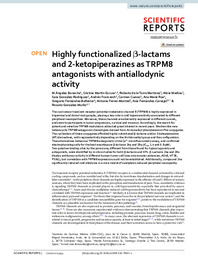Título :
Highly functionalized β‑lactams
and 2‑ketopiperazines as TRPM8
antagonists with antiallodynic
activity |
Autor :
Bonache, M. Ángeles
Martín Escura, Cristina 
De la Torre Martínez, Roberto
Medina, Alicia 
González-Rodríguez, Sara 
Francesch, Andres 
Cuevas, Carmen
Roa, Ana María
Fernández-Ballester, Gregorio
Ferrer-Montiel, Antonio 
Fernández Carvajal, Asia
González-Muñiz, Rosario |
Editor :
Nature Research |
Departamento:
Departamentos de la UMH::Bioquímica y Biología Molecular |
Fecha de publicación:
2020 |
URI :
https://hdl.handle.net/11000/35239 |
Resumen :
The cool sensor transient receptor potential melastatin channel 8 (TRPM8) is highly expressed in
trigeminal and dorsal root ganglia, playing a key role in cold hypersensitivity associated to diferent
peripheral neuropathies. Moreover, these channels are aberrantly expressed in diferent cancers,
and seem to participate in tumor progression, survival and invasion.Accordingly, the search for
potent and selectiveTRPM8 modulators attracted great interest in recent years.We describe new
heterocyclicTRPM8 antagonist chemotypes derived from N-cloroalkyl phenylalaninol-Phe conjugates.
The cyclization of these conjugates aforded highly substituted β-lactams and/or 2-ketopiperazine
(KP) derivatives, with regioselectivity depending on the N-chloroalkyl group and the confguration.
These derivatives behave asTRPM8 antagonists in the Ca2+ microfuorometry assay, and confrmed
electrophysiologically for the best enantiopure β-lactams 24a and 29a (IC50, 1.4 and 0.8 µM).
Two putative binding sites by the pore zone, diferent from those found for typical agonists and
antagonists, were identifed by in silico studies for both β-lactams and KPs. β-Lactams 24a and 29a
display antitumor activity in diferent human tumor cell lines (micromolar potencies,A549, HT29,
PSN1), but correlation withTRPM8 expression could not be established.Additionally, compound 24a
signifcantly reduced cold allodynia in a mice model of oxaliplatin-induced peripheral neuropathy.
|
Área de conocimiento :
CDU: Ciencias puras y naturales: Biología |
Tipo de documento :
info:eu-repo/semantics/article |
Derechos de acceso:
info:eu-repo/semantics/openAccess |
DOI :
https://doi.org/10.1038/s41598-020-70691-x |
Publicado en:
Scientific Reports | (2020) 10:14154 |
Aparece en las colecciones:
Artículos Bioquímica y Biología Molecular
|
 La licencia se describe como: Atribución-NonComercial-NoDerivada 4.0 Internacional.
La licencia se describe como: Atribución-NonComercial-NoDerivada 4.0 Internacional.
.png)
